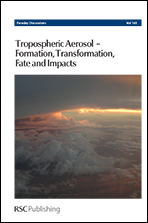Modeling the influence of alkane molecular structure on secondary organic aerosol formation
Abstract
Secondary Organic Aerosols (SOA) production and ageing is a multigenerational oxidation process involving the formation of successive organic compounds with higher oxidation degree and lower vapor pressure. Intermediate Volatility Organic Compounds (IVOC) emitted to the atmosphere are expected to be a substantial source of SOA. These emitted IVOC constitute a complex mixture including linear, branched and cyclic alkanes. The explicit gas-phase oxidation mechanisms are here generated for various linear and branched C10–C22 alkanes using the GECKO-A (Generator for Explicit Chemistry and Kinetics of Organics in the Atmosphere) and SOA formation is investigated for various homologous series. Simulation results show that both the size and the branching of the carbon skeleton are dominant factors driving the SOA yield. However, branching appears to be of secondary importance for the particle oxidation state and composition. The effect of alkane molecular structure on SOA yields appears to be consistent with recent laboratory observations. The simulated SOA composition shows, however, an unexpected major contribution from multifunctional organic nitrates. Most SOA contributors simulated for the oxidation of the various homologous series are far too reduced to be categorized as highly oxygenated organic aerosols (OOA). On a carbon basis, the OOA yields never exceeded 10% regardless of carbon chain length, molecular structure or ageing time. This version of the model appears clearly unable to explain a large production of OOA from alkane precursors.
- This article is part of the themed collection: Tropospheric Aerosol – Formation, Transformation and Impacts

 Please wait while we load your content...
Please wait while we load your content...